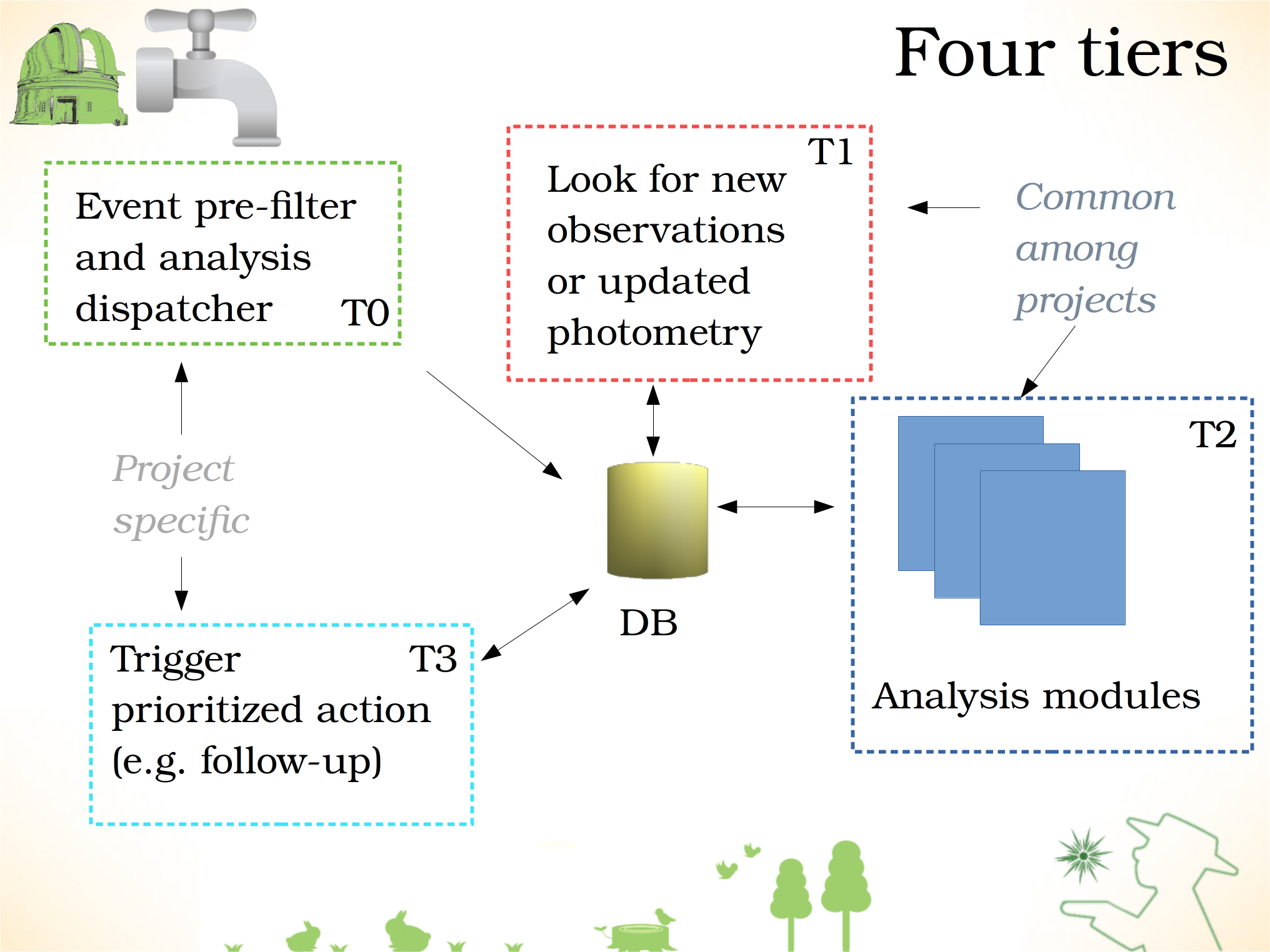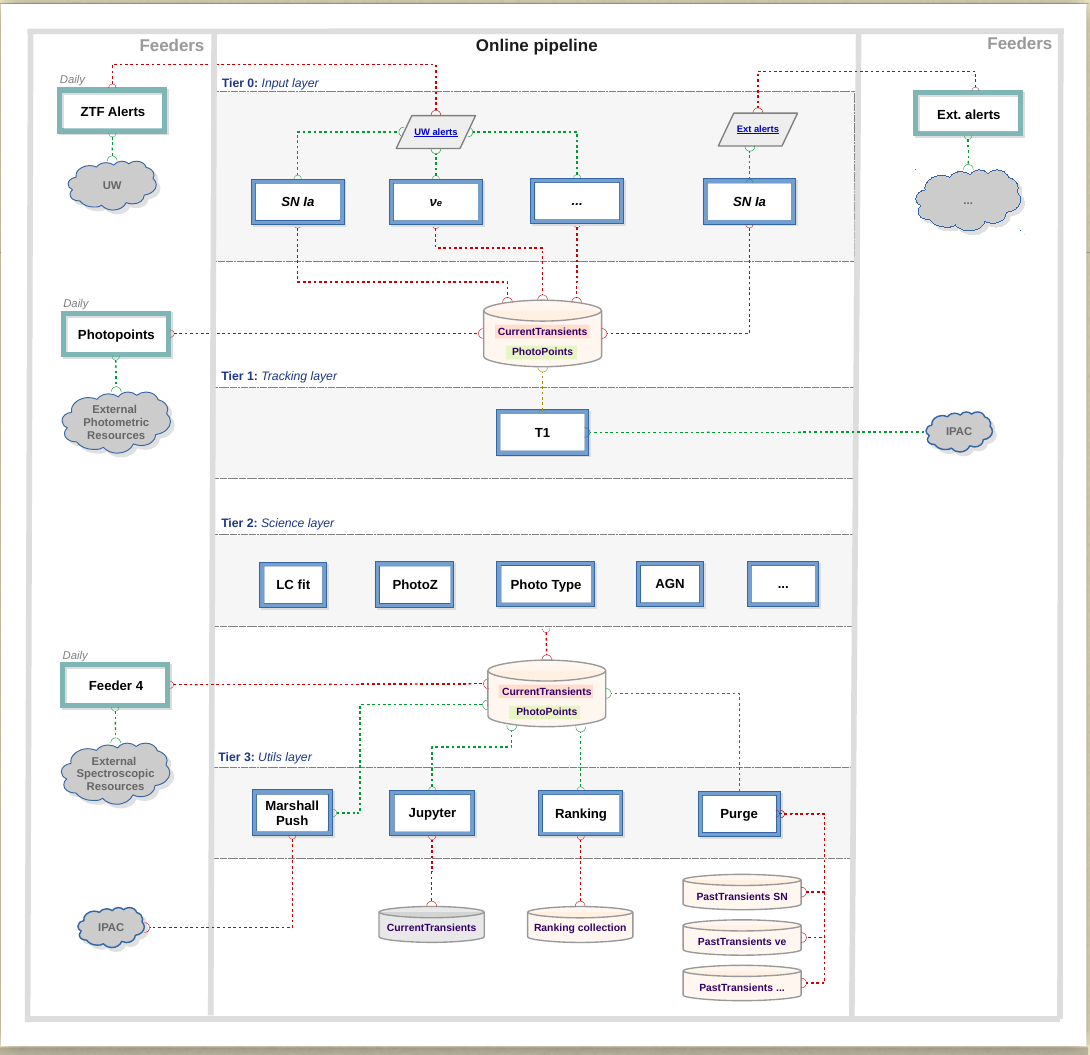
Difference: CosmoAMPEL (1 vs. 3)
Revision 32017-12-15 - ValeryBrinnel
Revision 22017-12-15 - JakobNordin
| Line: 1 to 1 | ||||||||
|---|---|---|---|---|---|---|---|---|
AMPEL : Alert Management, Photometry and Estimation of Lightcurves | ||||||||
| Changed: | ||||||||
| < < | A new era of wide-field optical photometric surveys will detect more astronomical transients than can be selected for detailed study, let alone be visually inspected in real-time. This will be implemented as continuous streams of alerts that are distributed by brokers. Astronomers, that previously could monitor a limited pool of nightly transients, are now tasked with processing alerts based on a limited set of detection statistics. AMPEL is designed as a flexible and powerful tool for not only completing this initial selection process, but also for the continuous monitoring of active transients and automatic selection of transients for further observations and/or analysis.
A user of AMPEL provides implementations of two simple python classes. The first (Tier 0) specifies alert selection criteria for potentially interesting candidates. These can range from simple (magnitude beyond threshold) to complex (detections in multiple filter, minimal mag diff with time and coincidental with the position of external triggers like GW, neutrinos or gamma-rays). The second (Tier 3) specifies how live candidates should be ranked and allows automatic action to be taken based on these. Ranking can be based on the raw photometry available in the alerts, but also incorporate added information such as photometric redshift, photometric classification, projected peak time/magnitude and visibility at a specific telescope site. The ranked list of transients can be the basis for e-mail alerts or automatic circulars, or downloaded as the recommended target list for follow-up facilities.
| |||||||
| > > | We will try to keep and update an introduction to AMPEL here, check back in early Jan for more info. | |||||||
| Changed: | ||||||||
| < < | The AMPEL pipeline will provide two automatic layers: continuous monitoring of all transients tagged as interesting by users, and derivation of additional transient information for these. The monitoring step keeps track of new alerts where the same transient was rediscovered as well as survey non-detections. These will be critical as transients can be observed but not fulfill all criteria necessary for triggering new alerts. The final AMPEL deruvation layer provides a convenient framework for adding transient information based on external and updated photometric data. Already planned modules include for host galaxy photometric redshifts, comparisons with transient template lightcurves and photometric typing algorithms, but all user can and are encouraged to contribute further modules. These can, but must not, be made available to other users. AMPEL will have unique capabilities to deliver transient samples with well understood selection functions and background estimates. In an era where large number of transients are detected, the limiting factor in understanding the astrophysical populations will shift to quantifying the transient fraction that was not fully observed. AMPEL accomplishes this through two key design features: First, it is possible to design a fully automatic transient survey, limiting the non-tractable human intervention to a minimum. Secondly, the full pipeline exists in a container instance. This will not only allow the exact survey sequence to be generated at later times, but also allows multiple simulated versions of the executed survey to be easily completed. This can conveniently provide answers to questions such as what sample would have been observed with infinite spectroscopic resources or more generous selection criteria. AMPEL is developed at HU berlin and will be initially deployed at the DESY-Zeuthen computer cluster. It consistently keeps track on user rights both to software and data, and seamlessly integrates updated calibration solutions into the derived properties. Code documentation is available at the AmpelProject GitHub. This will contain the base Tier abstract classes as well as sample implementations and directories where users can submit their code for testing and implementation. We will during the testing phase restrict the number of users and you will have to contact JakobNordin or Valery Brinnel to get repository access. | |||||||
| > > | A new era of wide-field optical photometric surveys will detect more astronomical transients than can be selected for detailed study, let alone be visually inspected in real-time. This will be implemented as continuous streams of alerts that are distributed by brokers. Astronomers, that previously could monitor a limited pool of nightly transients, are now tasked with processing alerts based on a limited set of detection statistics. AMPEL is designed as a flexible and powerful tool for not only completing this initial selection process, but also for the continuous monitoring of active transients and automatic selection of transients for further observations and/or analysis. | |||||||
| Changed: | ||||||||
| < < |
| |||||||
| > > | Code documentation is available at the AmpelProject GitHub. This will contain the base Tier abstract classes as well as sample implementations and directories where users can submit their code for testing and implementation. We will during the testing phase restrict the number of users and you will have to contact JakobNordin or Valery Brinnel to get repository access. | |||||||
AMPEL Workshop Berlin 12/13th Dec 2017 | ||||||||
| Line: 25 to 14 | ||||||||
| Members of the Berlin, Weizmann and OKC met up to discuss science requirements for different ZTF projects, what software are required to achieve this and how AMPEL can be used to run these in a consistent and convenient way. Smaller groups were formed to discuss requirements on Star/Galaxy separation, host galaxy identification and TNS/Wiserep integration. We will work together to implement an early SN trigger with minimal scanning requirements. Main steps of the time-line for the next months development work: | ||||||||
| Changed: | ||||||||
| < < |
| |||||||
| > > |
| |||||||
| ||||||||
Revision 12017-12-15 - JakobNordin
| Line: 1 to 1 | |||||||||||
|---|---|---|---|---|---|---|---|---|---|---|---|
| Added: | |||||||||||
| > > |
AMPEL : Alert Management, Photometry and Estimation of LightcurvesA new era of wide-field optical photometric surveys will detect more astronomical transients than can be selected for detailed study, let alone be visually inspected in real-time. This will be implemented as continuous streams of alerts that are distributed by brokers. Astronomers, that previously could monitor a limited pool of nightly transients, are now tasked with processing alerts based on a limited set of detection statistics. AMPEL is designed as a flexible and powerful tool for not only completing this initial selection process, but also for the continuous monitoring of active transients and automatic selection of transients for further observations and/or analysis. A user of AMPEL provides implementations of two simple python classes. The first (Tier 0) specifies alert selection criteria for potentially interesting candidates. These can range from simple (magnitude beyond threshold) to complex (detections in multiple filter, minimal mag diff with time and coincidental with the position of external triggers like GW, neutrinos or gamma-rays). The second (Tier 3) specifies how live candidates should be ranked and allows automatic action to be taken based on these. Ranking can be based on the raw photometry available in the alerts, but also incorporate added information such as photometric redshift, photometric classification, projected peak time/magnitude and visibility at a specific telescope site. The ranked list of transients can be the basis for e-mail alerts or automatic circulars, or downloaded as the recommended target list for follow-up facilities.
AMPEL Workshop Berlin 12/13th Dec 2017Members of the Berlin, Weizmann and OKC met up to discuss science requirements for different ZTF projects, what software are required to achieve this and how AMPEL can be used to run these in a consistent and convenient way. Smaller groups were formed to discuss requirements on Star/Galaxy separation, host galaxy identification and TNS/Wiserep integration. We will work together to implement an early SN trigger with minimal scanning requirements. Main steps of the time-line for the next months development work:
| ||||||||||
View topic | History: r3 < r2 < r1 | More topic actions...
Ideas, requests, problems regarding TWiki? Send feedback

